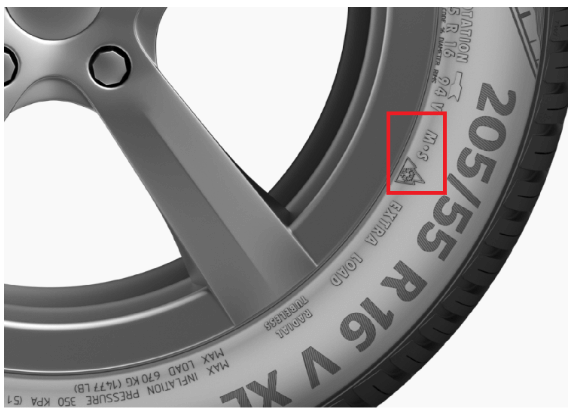How to Tell If Tire is All Season
To tell if a tire is all-season, check the sidewall for “M+S” or “M/S” symbols. These indicate all-season capability.
All-season tires provide good traction in various weather conditions, making them suitable for year-round use. Designed to perform adequately in both dry and wet conditions, these tires are a versatile choice for most drivers. They feature a tread pattern that can handle different road surfaces and temperatures, offering a balance of performance and longevity.
All-season tires are popular for their convenience, eliminating the need for frequent seasonal tire changes. By understanding the key characteristics of all-season tires, you can make an informed decision when selecting the right tires for your vehicle.

Credit: www.westwindhonda.ca
Benefits Of All-season Tires
All-season tires are a popular choice for drivers looking for versatility and cost-effectiveness. These tires are designed to perform well in a variety of weather conditions, making them suitable for use throughout the year. Understanding the benefits of all-season tires can help you make an informed decision when it comes to selecting the right tires for your vehicle.
Versatility
All-season tires are engineered to provide reliable traction in both dry and wet conditions, as well as light snow. This versatility makes them a practical option for drivers who experience a range of weather patterns throughout the year. Whether you’re navigating city streets or embarking on a road trip, all-season tires offer the flexibility needed to handle diverse driving environments.
Cost-effective
Opting for all-season tires can prove to be a cost-effective choice for drivers. With these tires, there’s no need for frequent seasonal replacements, saving you both time and money. The convenience of having a single set of tires that can handle various weather conditions ensures that you won’t need to invest in separate sets of tires for different seasons, making all-season tires a smart and economical investment for many drivers.
Key Features Of All-season Tires
All-season tires are designed to perform well in various weather conditions, making them a versatile choice for drivers. To determine if a tire is all-season, look for the M+S (mud and snow) symbol on the sidewall, which indicates its ability to handle different road conditions.
All-season tires are designed to provide optimal performance in a variety of weather conditions, making them a versatile choice for many drivers. When selecting all-season tires, it’s important to understand the key features that set them apart.Tread Pattern
All-season tires have a unique tread pattern that combines elements of both summer and winter tires. The tread pattern is designed to provide traction on wet and dry roads, as well as light snow.Tread Compound
The tread compound of all-season tires is formulated to remain flexible in a wide range of temperatures. This flexibility allows the tires to maintain grip in both hot and cold conditions, enhancing overall performance. In summary, all-season tires offer a balanced combination of features that make them suitable for year-round use.Tire Labels And Ratings
M+s And Three-peak Mountain Snowflake Symbols
M+S Symbol: Indicates that the tire is suitable for mud and snow conditions.
Three-Peak Mountain Snowflake Symbol: Signifies winter tire capabilities for severe snow conditions.
Traction, Temperature, And Treadwear Ratings
- Traction Rating: Reflects a tire’s grip on wet roads, graded from AA (highest) to C (lowest).
- Temperature Rating: Indicates a tire’s ability to withstand heat, ranging from A (best) to C (worst).
- Treadwear Rating: Measures how long a tire is expected to last compared to a base tire score of 100.
Tires with higher ratings typically offer better performance and longevity.
Visual Inspection
When it comes to determining if a tire is all-season, a visual inspection is an initial step. This type of inspection can help you identify key features of the tire, such as tread depth and wear indicators. By paying attention to these visual cues, you can evaluate whether a tire is suitable for all-season use.
Tread Depth
The tread depth of a tire is a crucial factor in determining its all-season capabilities. To assess the tread depth, use a tread depth gauge to measure the depth of the tire’s grooves. All-season tires generally have deeper treads to provide better traction in various weather conditions.
Wear Indicators
Inspecting the wear indicators is another important aspect of determining if a tire is suitable for all-season use. Wear indicators are small raised bars within the tire grooves that become more visible as the tire wears down. If the wear indicators are easily noticeable, it may be time to replace the tire, indicating it is no longer suitable for all-season use.
Driving Performance In Different Conditions
To determine if a tire is all-season, check for the M+S symbol on the sidewall. This signifies the tire’s ability to perform in various conditions, including rain and light snow. Look for the three-peak mountain snowflake symbol which indicates enhanced traction in severe winter conditions.
Dry Road Handling
All-season tires are designed to provide reliable performance on dry roads. Their tread patterns and rubber compounds are optimized for traction and stability. With their firm grip and responsive handling, these tires offer a smooth and controlled driving experience on dry surfaces. Whether you are cruising down the highway or taking on winding roads, all-season tires excel in delivering precise steering and excellent braking performance on dry roads.Wet Road Grip
When it comes to wet road grip, all-season tires are designed to provide adequate traction and prevent hydroplaning. The tread pattern of these tires features grooves and sipes that efficiently channel water away from the tire surface, enhancing traction on wet roads. The special tread compound used in all-season tires ensures optimal grip in rainy conditions, minimizing the chances of skidding or sliding. With improved grip, these tires offer better control and handling, even on wet surfaces, allowing you to stay safe and confident behind the wheel.Winter Conditions
One of the key advantages of all-season tires is their ability to perform well in a variety of weather conditions, including winter. While they are not as specialized as dedicated winter tires, they still offer decent traction and grip on icy or snowy roads. All-season tires usually feature a moderate tread design with biting edges that provide some level of traction on slick surfaces. However, it is important to note that all-season tires may not offer the same level of performance as true winter tires in severe winter conditions. If you frequently encounter heavy snow or ice, switching to dedicated winter tires is recommended for optimal safety on the road. In conclusion, all-season tires offer good performance in various driving conditions, including dry roads, wet surfaces, and even mild winter conditions. While they may not provide the same level of traction as specialized tires in extreme weather conditions, they offer a versatile option for drivers who encounter a mix of weather conditions throughout the year. By understanding the driving performance of all-season tires in different conditions, you can make an informed decision and choose the right tires for your vehicle.
Credit: m.youtube.com

Credit: blog.atseuromaster.co.uk
Frequently Asked Questions On How To Tell If Tire Is All Season
How Do I Know If My Tires Are Winter Or All Season?
Check the tire sidewall for markings like “M+S” or a mountain snowflake symbol to identify winter tires. All-season tires may have “all season” or “A/S” on the sidewall.
What Is The Symbol For All Season Tires?
The symbol for all season tires is the letters “M+S,” which stands for mud and snow.
How Do You Tell If Your Tyres Are All Season?
You can check if your tyres are all-season by looking at the sidewall for symbols like M+S, mud and snow, or a mountain with a snowflake. Additionally, All-season tyres typically have a longer tread life and are designed to perform well in various weather conditions.
How To Tell The Difference Between All Season And All Weather Tires?
All season tires are designed to provide adequate traction in various weather conditions. All weather tires, on the other hand, are specifically engineered to navigate extreme winter weather. Their rubber compounds and tread patterns differ, making all weather tires more effective in snow and ice compared to all season tires.
How Can I Tell If My Tire Is An All-season Tire?
All-season tires are designed with a specific tread pattern that provides good traction in both wet and dry conditions. Look for the “M+S” symbol on the sidewall of the tire, indicating that it is an all-season tire.
What Are The Benefits Of Using All-season Tires?
All-season tires offer versatility and convenience by providing reliable traction in different weather conditions. They are suitable for moderate climates and eliminate the need for seasonal tire changes.
Can I Use All-season Tires In Winter?
While all-season tires are designed to perform well in various conditions, they are not specifically made for snowy or icy roads. For severe winter conditions, it is recommended to use winter tires that have specialized tread patterns and rubber compounds.
Conclusion
Knowing how to identify an all-season tire is essential for optimal performance year-round. Consider the tread pattern, tire label, and climatic conditions in your area to determine if your tire is suitable for all seasons. By understanding these key indicators, you can ensure your vehicle is equipped with the right tires for safe and efficient driving in any weather.

